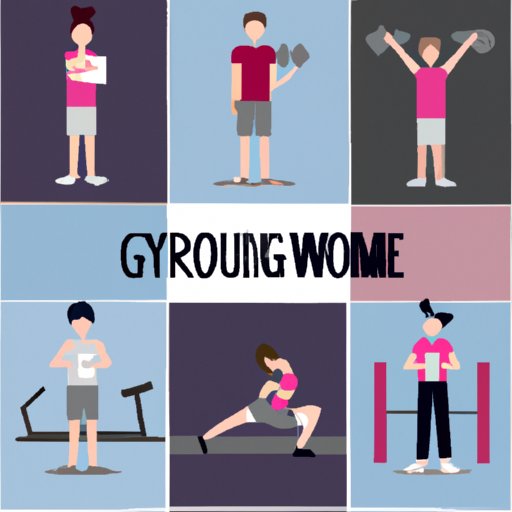
I. Introduction
If you’re looking to lose weight, visiting a gym is a great step towards achieving your goal. With a wide range of equipment and options available, it’s easy to feel overwhelmed or unsure of where to start. This article explores the best gym workouts to help you lose weight effectively and keep it off.
II. Use Interval Training
Interval training is a workout technique that alternates between high-intensity exercises and brief periods of rest or lower intensity. It can help you burn more calories than typical steady-state cardio while spending less time exercising. Research has also shown that interval training can improve cardiovascular health, blood sugar levels, and metabolic rate, making it an effective tool for weight loss.
To incorporate interval training at the gym, try activities such as running on a treadmill, cycling, or using an elliptical machine. Begin with a warm-up and then alternate between high and low-intensity intervals for a set amount of time, increasing the intensity as you become fitter. Remember to cool down and stretch at the end of the workout.
For effective interval training routines, it is best to work with a personal trainer who can help you develop a workout customized to your fitness level and needs. If you’re working on your own, start with shorter intervals and gradually increase the time or intensity as you improve.
III. Strength Training
Strength training, or resistance training, is an exercise technique that helps to sculpt and tone muscles while also burning calories. Building muscle mass can help increase your overall metabolism, improve balance, and reduce the risk of injury. Strength training can be done with equipment like weights, resistance bands, or using your body weight.
If you are new to strength training, start on a low weight, and focus on good form and technique. Gradually increase the weight as you become stronger and confident. A certified personal trainer can also help you develop an exercise regimen tailored to your fitness level and goals. Aim to work all major muscle groups 2-3 times per week, with rest days in between.
IV. Cardiovascular Activities
Cardiovascular activities are exercises that raise your heart rate and breathing rate, utilizing more oxygen while burning calories. This includes activities such as running, cycling, swimming, dancing, and using cardio machines. Cardiovascular activities can help you burn calories, reduce stress levels, and improve heart health.
When incorporating cardiovascular activities, aim for at least 150 minutes of moderate-intensity exercise per week, spread across the week to ensure you get enough activity. You can also try high-intensity interval training, which can be a great time-saver and an excellent way to burn calories in a shorter workout.
V. Group Workouts
Group workout classes can be an excellent way to help you stick to your fitness routine by providing motivation and diversity. Group workouts can include activities like spinning, dance classes, Pilates, and boot camp-style workouts. Exercising in a group can be more fun, help keep you accountable, and provide an outlet to meet new people with similar goals.
When choosing a group workout class, consider your fitness level and any potential injuries or restrictions. Make sure the class or instructor suits your schedule and preference. You can ask a personal trainer for recommendations or read reviews online to ensure the class is a good fit for you.
VI. Increase your Protein Intake
Protein is an essential nutrient for our bodies. It can help build and maintain muscle mass, regulate appetite, and keep us feeling fuller for longer. Protein intake can also help with weight loss by reducing cravings and enhancing energy levels. Healthy protein sources include lean meats, eggs, beans, and legumes, milk, and dairy products, as well as vegetarian options like tofu and quinoa.
To increase your protein intake, try having protein-rich breakfast meals like eggs or oats with milk instead of sugary cereals, or include protein snacks like nuts or cottage cheese. Aiming to have a small serving of protein with each meal or snack can help you feel fuller for longer and reduce snacking between meals.
VII. Keep a Food Diary
Keeping a food diary can be an effective way to monitor what you eat and make changes to your diet for weight loss. A food diary can help you identify patterns, and areas where you may be eating more than you realize. Aim to write everything you eat or drink, and quantify the portions and calories if possible. This can help you make informed choices and avoid mindlessly snacking throughout the day.
When keeping a food diary, try writing down how you felt emotionally and physically before and after your meal. This can help you identify potential triggers such as emotional eating or foods that make you feel more tired or sluggish. With this information, you can make adjustments to your diet, and work towards healthy eating habits.
VIII. Conclusion
When it comes to losing weight, engaging in effective gym workouts can help you reach your goals. Incorporating interval training, strength training, and cardiovascular activities can help you burn calories, build lean muscle mass, and improve your overall health. Group workout classes can add variety and social support, while increasing your protein intake and keeping a food diary can help support healthy habits. With these tips and suggestions, you can create a successful weight loss program that works for you.
Remember to start slowly, gradually increasing the intensity, duration, or frequency of your workouts, and always pay attention to your body’s signals. Speak to a healthcare professional or personal trainer if you have any questions or concerns.





